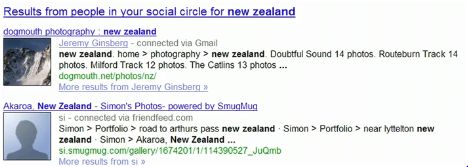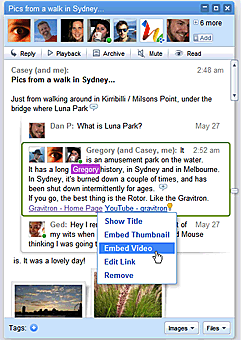 Over the last few years, the popularity of social channels – for professionals, teens, grandmas and everyone in between – has skyrocketed. Consider the recent numbers:
Over the last few years, the popularity of social channels – for professionals, teens, grandmas and everyone in between – has skyrocketed. Consider the recent numbers:
- Twitter experienced an annual growth in 2009 of 1,382%
- Facebook now boasts 400 million active users
- Every minute, 20 hours of video are uploaded to YouTube
Between blog posts, Facebook status updates, tweets, videos and every other piece of social content published, there’s a whole lot of information floating around out there.
Enter the latest social media player, Google.
Google’s latest activities, acquisitions and features all point to the fact that the search giant no longer has a close eye on web 2.0; it’s already there.
Here are 5 ways Google is now becoming a dominant social media player:
1. Google Social Search
- Google Social Search results
Until now all of the social content in channels like Twitter, Facebook and LinkedIn, hasn’t been easy to find in a central place – including through Google search. Until now, that is.
That’s where Google Social Search comes in. It’s still in the experimental stages, but this new feature combines users’ social connections with organic searches. For example, if you were to search for “New Zealand,” social search results would appear beneath the organic search results. The tool scans your social connections’ content (based on the social accounts included in your Google profile) to create these results.
2. Google Buzz
These days, it seems the social world is abuzz with talk of Google Buzz. This new product is built into Gmail and essentially turns users’ inboxes into social networks. A mobile version of Google Buzz is also available.
Here’s how it works: Google Buzz leverages current email contacts and connects you with their social profiles. Through Gmail, you can share status updates and photos, and start conversations, all through from your email.
What does this mean for your brand? You may want to consider adding Gmail to your social media marketing mix.
3. Twitter and Facebook Feeds in Search Results
Imagine the tweets highlighting your latest blog post or a new product launch getting found in organic searches. These days, that’s a reality.
At the end of February, Google happily announced on Twitter that public status updates from Facebook fan pages would now be included in real-time search. Facebook joins a long list of other social content appearing in search results including:
- Twitter tweets
- FriendFeed updates
- Google Buzz posts
- MySpace updates
Twitter and Facebook marketing efforts, then, take on new importance and new meaning. It’s now essential that all social content be optimized just as other online content is optimized.
4. Google’s Social Acquisitions
Still not convinced that Google’s sights are set on social? Just check out the list of its acquisitions over the last nine years, and count the social platforms.
In terms of sites owned by Google, the search giant has the gamut covered:
- Video Sharing: YouTube
- Blogging Tool: Blogger.com
- Wiki: Knol
- Social Networking: Orkut
- Image Sharing: Picasa
- Social Search: Aardvark
5. Google Wave
Essentially, Google Wave is 21st century email. The tool enables real-time communication and collaboration – i.e., share images, post videos, discuss ideas. Within Google Wave, you can create a message, invite other users to take part in the discussion, and add files, images, videos, you name it.
The coolest part about the tool is conversations are live, but you can rewind the wave at any time to see a previous comment.
It’s only available in limited preview right now, and you need an invitation from Google to join. Unfortunately, I’m not one of the lucky ones. Google, if you’re out there, can you hear me?
There’s no doubt about it: Google’s gone social. What’s up in the air is where it will go next. What do you think will be the next Google social media tools or applications?





